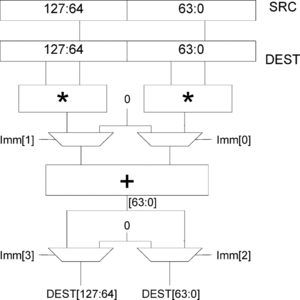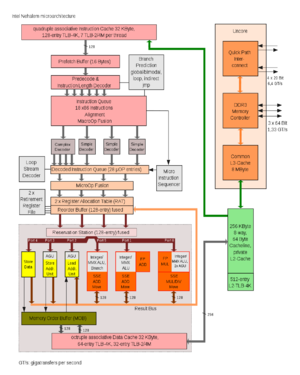Check out my first novel, midnight's simulacra!
SIMD: Difference between revisions
Jump to navigation
Jump to search
No edit summary |
|||
| Line 5: | Line 5: | ||
** [http://gcc.gnu.org/onlinedocs/gcc/Submodel-Options.html#Submodel-Options Target-specific code generation] will sometimes use scalar SIMD | ** [http://gcc.gnu.org/onlinedocs/gcc/Submodel-Options.html#Submodel-Options Target-specific code generation] will sometimes use scalar SIMD | ||
** [http://gcc.gnu.org/onlinedocs/gcc/Target-Builtins.html Target-specific builtins], using [http://gcc.gnu.org/onlinedocs/gcc/Vector-Extensions.html vector extensions] | ** [http://gcc.gnu.org/onlinedocs/gcc/Target-Builtins.html Target-specific builtins], using [http://gcc.gnu.org/onlinedocs/gcc/Vector-Extensions.html vector extensions] | ||
** [[GCC#Inline_Assembly|Inline assembly]], using syntax of the | ** [[GCC#Inline_Assembly|Inline assembly]], using syntax of the [http://sourceware.org/binutils/docs/as/index.html GNU Assembler] and a baroque register specification convention | ||
** [http://gcc.gnu.org/projects/tree-ssa/vectorization.html Auto-vectorization] from [[GCC|gcc's]] <tt>autovect</tt> branch attempts to autovectorize some loops | ** [http://gcc.gnu.org/projects/tree-ssa/vectorization.html Auto-vectorization] from [[GCC|gcc's]] <tt>autovect</tt> branch attempts to autovectorize some loops | ||
Revision as of 07:59, 4 October 2009
First introduced on the Illiac IV, and not to be confused with vector processing.
Compilers and Assemblers
- GCC can issue SIMD four different ways:
- Target-specific code generation will sometimes use scalar SIMD
- Target-specific builtins, using vector extensions
- Inline assembly, using syntax of the GNU Assembler and a baroque register specification convention
- Auto-vectorization from gcc's autovect branch attempts to autovectorize some loops
Data Types (taken from SSE specs)
These do not necessarily map to the C data types of the same name, for any given compiler!
- half precision: 16-bit IEEE 754 floating-point (bias-15) (IEEE 754 2008 binary16)
- single: 32-bit IEEE 754 floating-point (bias-127) (IEEE 754 2008 binary32)
- double: 64-bit IEEE 754 floating-point (bias-1023) (IEEE 754 2008 binary64)
- long double: 80-bit "double extended" IEEE 754-1985 floating-point (bias-16383)
- not an actual SIMD type, but an artifact of x87
- word: 32-bit two's complement integer
- doubleword, dword: 64-bit two's complement integer
x86 XMM
The Streaming SIMD Extensions operate on the 128-bit XMM registers (XMM0..XMM7 in 32-bit mode, XMM0..XMM15 in 64-bit mode). In its original incarnation on the PIII, execution units (but not registers) were shared with the x87 floating-point architecture. The execution units were separated in the NetBurst microarchitecture. In the Core microarchitecture, the execution engine has been widened for greater SSE throughput.
SSE5 (AMD)
- Unimplemented extensions competing with SSE4, encoded using a method incompatible with VEX
- Withdrawn, converted into VEX-compatible encodings, and split into:
- FMA4: Fused floating-point multiply-add (compare Intel's FMA)
- XOP: Fused integer multiply-add, byte permutations, shifts, rotates, integer vector horizontal operations (compare Intel's SSE4)
- CVT16: Half-precision conversion
SSE4 (Intel)
SSE4.1

- Introduced on Penryn
- dpps -- dot product of two vectors having four single components each
- dppd -- dot product of two vectors having two double components each
- insertps
SSE4.2

- Introduced on Nehalem
- crc32
- pcmpestri
- pcmpestrm
- pcmpistri
- pcmpistrm
- pcmpgtq
- popcnt
SSE4a (AMD)
- lzcnt
- popcnt
- extrq
- insertq
- movntsd
- movntss
SSE3 (PNI)
- Originally known as Prescott New Instructions, and introduced on P4-Prescott
- movddup -- move a double from a 8-byte-aligned memory location or lower half of XMM register to upper half, then duplicate upper half to lower half
SSSE3 (TNI/MNI)
- Introduced with the Core microarchitecture. Sometimes referred to as Tejas New Instructions or Merom New Instructions
- pmaddwd -- multiply packed words, then horizontally sum pairs, accumulating into doublewords
SSE2
- Introduced with the P4.
- Extends the MMX instructions to XMM registers.
- movapd -- move two packed doubles from a 16-byte-aligned memory location to XMM registers, or vice versa, or between two XMM registers.
- movupd -- movapd safe for unaligned memory references, with far inferior performance.
- mulpd -- multiply two packed doubles. the multiplier is a 16-byte-aligned memory location or XMM register. the target XMM register serves as the multiplicand.
- addpd -- add two packed doubles. the addend is a 16-byte-aligned memory location or XMM register. the target XMM register serves as the augend.
SSE (KNI/ISSE)
- Introduced with the PIII. Sometimes referred to as Katmai New Instructions, and branded for some time as the Internet Streaming SIMD Extensions
- movaps -- move four packed singles from a 16-byte-aligned memory location to XMM registers, or vice versa, or between two XMM registers.
- movups -- movaps safe for unaligned memory references, with far inferior performance.
- mulps -- multiply four packed singles. the multiplier is a 16-byte-aligned memory location or XMM register. the target XMM register serves as the multiplicand.
- addps -- add four packed singles. the addend is a 16-byte-aligned memory location or XMM register. the target XMM register serves as the augend.
Future Directions
- AVX (Advanced Vector eXtensions) -- to be introduced on Intel's Sandy Bridge (2010) and AMD's Bulldozer (2011), and implemented within the VEX coding scheme
- The FMA instruction set extension to x86 should hit around 2011, providing floating-point fused multiply-add
- AMD appears to call this FMA4, part of what was SSE5
x87 MMX
MMX (Intel)
3DNow! (AMD)
Other Architectures
- PowerPC implements AltiVec
- SPARC implements VIS, the Visual Instruction Set
- PA-RISC implements MAX, the Multimedia Acceleration eXtensions
- ARM implements NEON
- Alpha implemented MVI, the Motion Video Instructions
- SWAR: SIMD Within a Register (bit-parallel methods)
See Also
- "Why no FMA in AVX in Sandy Bridge?", Intel Developers Forum
- SSE5 guide at AMD
- SSE4 reference at Intel
- 2007-04-19 post to http://virtualdub.org, "SSE4 finally adds dot products"
- AMD64 Architecture Programmer’s Manual Volume 6: 128-Bit and 256-Bit XOP, FMA4 and CVT16 Instructions
- Agner Fog's x86 Instruction Tables
- General architecture page